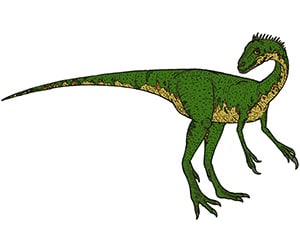Coelurus was a small theropod dinosaur in the family Coeluridae. The name “Coelurus” means “hollow tail,” referring to the hollow vertebrae found in the animal’s fossil remains.

The Coelurid lived during the Late Jurassic period, approximately 154 to 150 million years ago, in what is now North America.
Discovery and Fossils
The species Coelurus fragilis was first described by Othniel Charles Marsh in 1879. The fossil, found in the Morrison Formation, consists mainly of a postcranial skeleton.
The discovery was notable for the hollow nature of the vertebrae, a key feature in the classification of this dinosaur. Initially, Marsh was unsure if the fossil belonged to a dinosaur or another type of reptile, but further study confirmed its dinosaurian nature.
Physical Description

Coelurus was a small dinosaur, measuring about 2 metres (6 feet) in length and weighing approximately 20 kg (44 pounds). Its head was slightly smaller than a man’s hand, with small, curved, razor-sharp teeth.
Although it had long hands, they were relatively weak. Its hollow vertebrae contributed to a lightweight structure, which may have allowed it to move quickly. The tail made up a significant portion of its overall length.
Taxonomic History
Like many other dinosaurs from the Bone Wars era, Coelurus has a complicated taxonomic history. Over the years, several species were reclassified or reassigned to other genera. For example, C. agilis was absorbed into C. fragilis, and C. bauri was reassigned to Coelophysis bauri. Today, only Coelurus fragilis is recognised as a valid species in the genus.
Habitat and Ecology
Fossil evidence suggests that Coelurus lived in semi-arid environments such as floodplains and conifer forests. It likely hunted small prey such as insects and small vertebrates. Although fossils of its skull have not been discovered, its body structure and known relatives suggest it was a fast-moving carnivore. Its hollow bones and lightweight body likely gave it a speed advantage over its prey.
Species List
- C. fragilis Marsh, 1879 (type), now includes C. agilis Marsh, 1884, and Elaphrosaurus agilis.
- C. bauri Cope, 1887 is now included with Coelophysis bauri.
- C. daviesi Seeley, 1888/Lydekker, 1888 is included with Thecocoelurus daviesi.
- C. gracilis Marsh, 1888 is a nomen dubium included with Dromaeosaurus gracilis.
- C. hermanni Osborn, 1903/Hay, 1930 is included with Ornitholestes hermanni.
- C. longicollis Cope, 1887 is now considered the type specimen of Longosaurus.